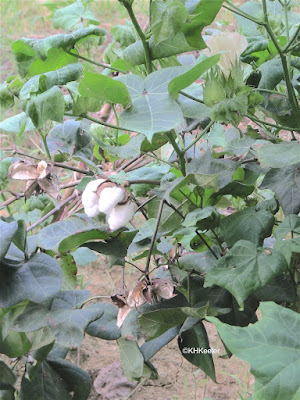The same applies to smaller plants
Pineapples (Ananas comosus, bromeliad family, Bromeliaceae), popularly associated with Hawaii, are from Central America and the Caribbean.
Chilis, chili peppers (Capsicum species, tomato family Solanaceae) are from the American tropics but they were carried all over the world in the 16th century and became essential in cuisines from Hungary to Sechuan.
 |
| chili peppers |
 |
| sweet potatoes |
 |
| bird-of-paradise |
 |
| sugar cane plants |
 |
| cotton plant |
 |
| ixora |
 This spectacular heliconia, sexy pink (Heliconius chartacea, heliconia family, Heliconiaceae), seen growing in Bali, is from the American tropics.
This spectacular heliconia, sexy pink (Heliconius chartacea, heliconia family, Heliconiaceae), seen growing in Bali, is from the American tropics.And so it goes. Plant after familiar plant has an international distribution as a result of human transport. Today it is easy to look up origins online so we are better informed and less often surprised.
I think that our attitudes have greatly changed. Surely the initial motivation was to share a great plant with people elsewhere. Today we question importing and growing "alien" species.
Why worry about having non-native species? Often because the natives are declining in numbers. Plants endemic to (found only on) a tropical island have no reserve populations should they get so rare their pollinators cannot find them. A hundred years ago, it was hard to imagine how vulnerable some native species are.
In moving plants to new continents, we also discovered that often they grew better. Taken out of its natural habitat, a plant left behind its natural enemies--viruses, bacteria, fungi, insects, birds, mice, deer, monkeys...anything that ate it. In the new land, the organisms that specialize on eating the introduced plant are simply not there. Even if the generalists that nibble everything like it, that is still many fewer enemies than in the plant's native range. So often the plants grew better than they did in their region of origin. This effect created some nasty weeds but it has been a boon to the world's economy: many of the places that are the big producers of economically important tropical plants today are half a world from where the plant is native, for example chocolate in Africa and bananas in the Americas.
 |
| vanilla flower |
With all the biological complexity and specificity of the tropics, it is surprising that there weren't more plants that failed to find all their requirements when moved to a new continent. Or maybe there were, but if the plants died, we may not to remember the unsuccessful introduction, especially if was a hundred or more years ago.
But many transported plants were resilient and today can be found growing well in South and Central America, Africa, India, Southeast Asia, Polynesia and more.
The good news is: since so many tropical plants are widely planted, when you learn some in Costa Rica that information will likely be useful to you wherever you travel in our world's tropics. But do note and appreciate natives, wherever you are. After all, all those widely cultivated plants are native somewhere.
Comments and corrections welcome.
Blogs in this series with more information on some of these plants:
Bird-of-paradise link
Heliconia link
Pineapple link
Sweet potatoes link
These and other similar stories in my books: Curious Stories of Familiar Garden Plants link and Curious Stories of Plants from Around the World link, available on amazon.com or from me.
Kathy Keeler, A Wandering Botanist
More at awanderingbotanist.com



No comments:
Post a Comment